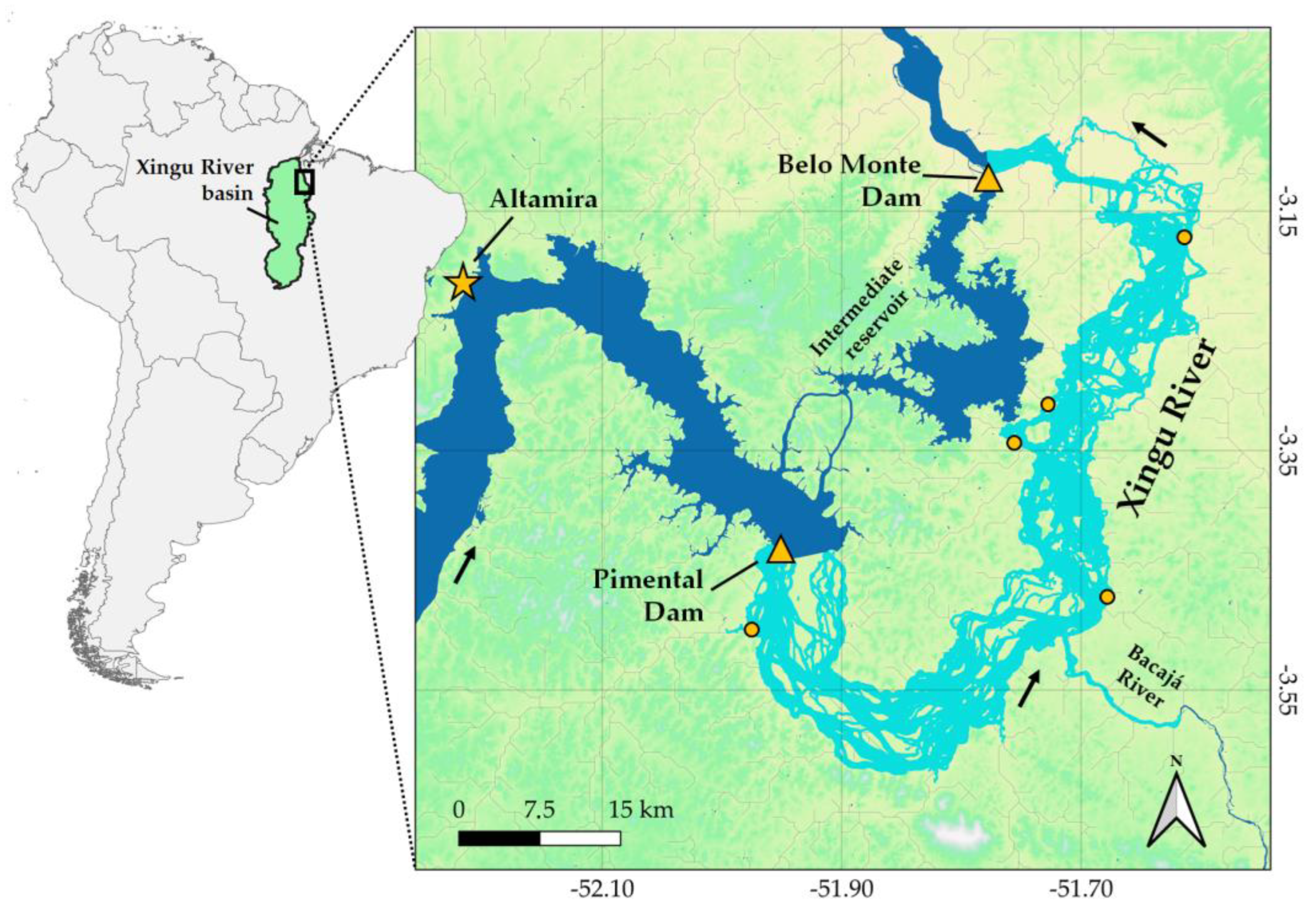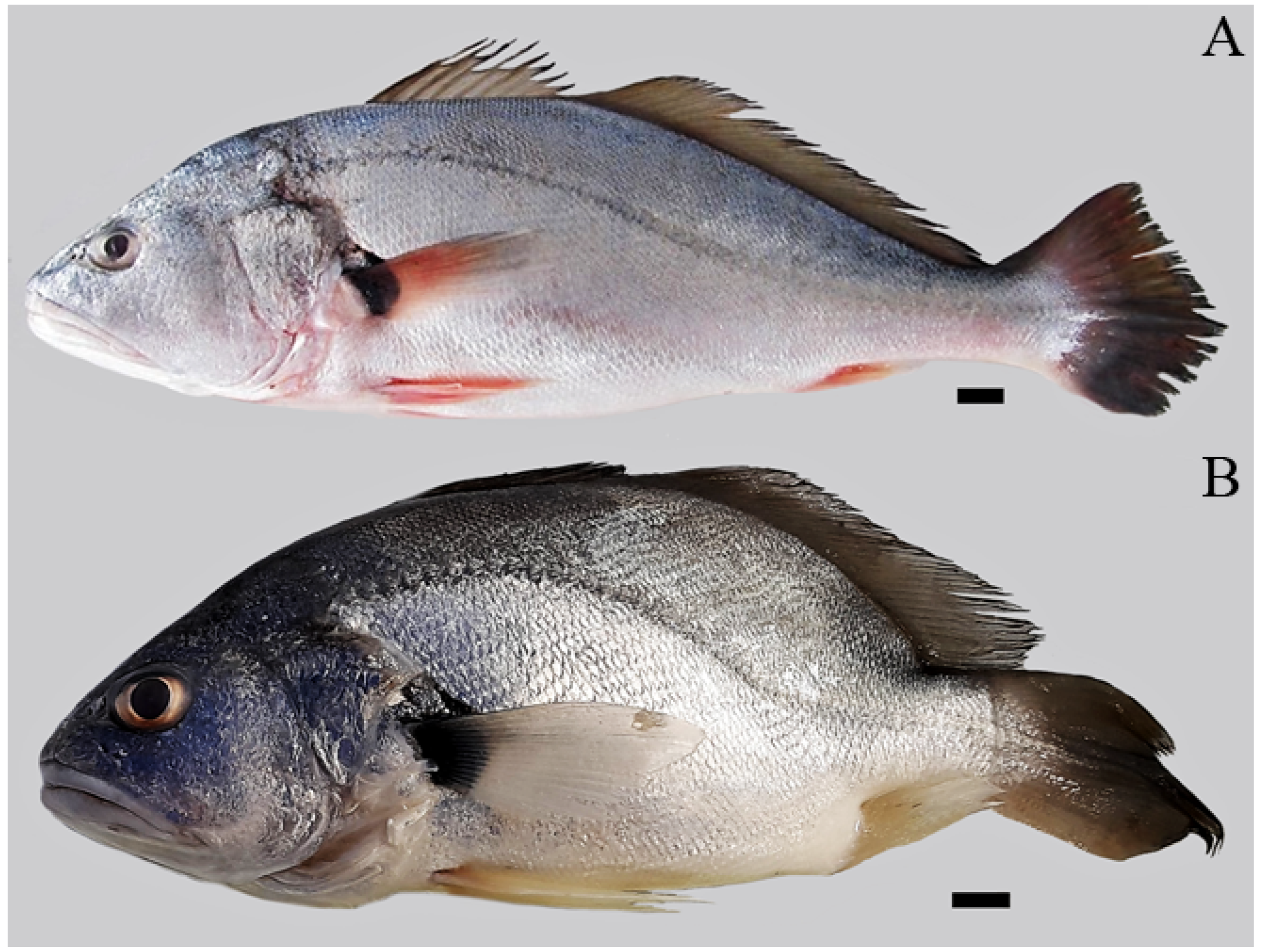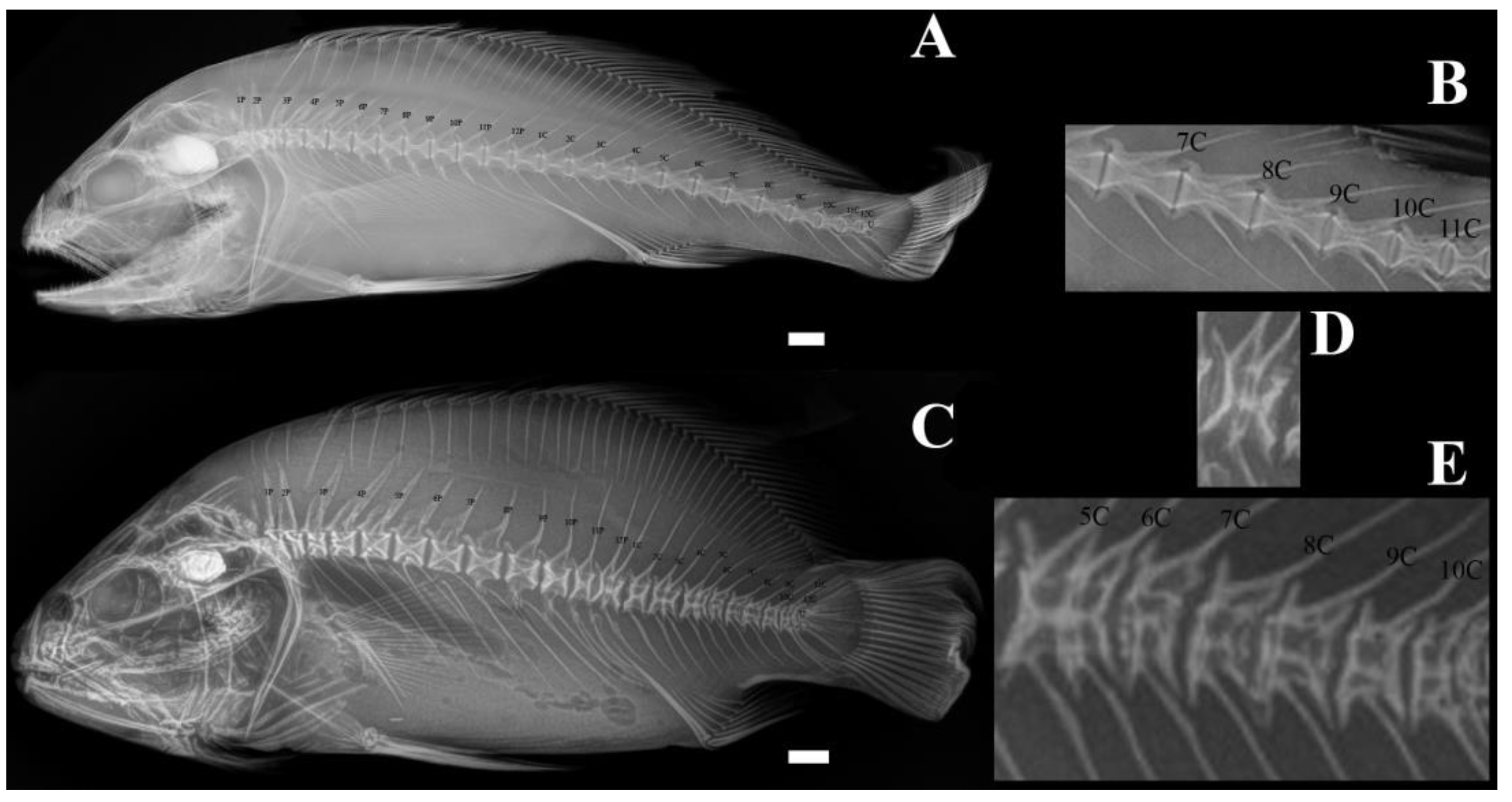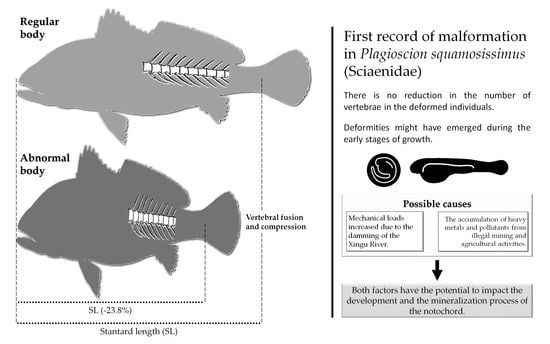First Record of Spinal Deformity in the South American Silver Croaker Plagioscion squamosissimus (Eupercaria: Sciaenidae) in the Xingu River, Brazil
Abstract
1. Introduction
2. Materials and Methods
3. Results
4. Discussion
5. Conclusions
Supplementary Materials
Author Contributions
Funding
Institutional Review Board Statement
Informed Consent Statement
Data Availability Statement
Acknowledgments
Conflicts of Interest
References
- Frank, J.; Schwartz, F.J.; Francesconi, J.F. A deformed, multi-spotted red drum, Sciaenops ocellatus (Sciaenidae), from North Carolina. J. Elisha Mitchell Sci. Soc. 1998, 114, 219–224. Available online: https://www.jstor.org/stable/24335465 (accessed on 5 May 2023).
- Fragkoulis, S.; Paliogiannis, H.; Kokkinias, P.; Chiers, K.; Adriaens, D.; Koumoundouros, G. Saddleback syndrome in European sea bass Dicentrarchus labrax (Linnaeus, 1758): Anatomy, ontogeny and correlation with lateral-line, anal and pelvic fin abnormalities. J. Fish Dis. 2017, 40, 83–95. [Google Scholar] [CrossRef]
- Eissa, A.E.; Abu-Seida, A.M.; Ismail, M.M.; Abu-Elala, N.M.; Abdelsalam, M. A comprehensive overview of the most common skeletal deformities in fish. Aquac. Res. 2021, 52, 2391–2402. [Google Scholar] [CrossRef]
- Zhou, F.; Huang, W.; Shan, X.; Shi, L.; Liu, Z. Early Development of the Spinal Vertebrae and Appendicular Skeleton in Miichthys miiuy Larvae. Aquac. Res. 2023, 2023, 4767850. [Google Scholar] [CrossRef]
- Kerniske, F.F.; Castro, J.P.; Ossa-Guerra, L.E.; Mayer, B.A.; Abilhoa, V.; Affonso, I.P.; Artoni, R.F. Spinal malformations in a naturally isolated Neotropical fish population. PeerJ 2021, 9, e12239. [Google Scholar] [CrossRef] [PubMed]
- Sfakianakis, D.G.; Renieri, E.; Kentouri, M.; Tsatsakis, A.M. Effect of heavy metals on fish larvae deformities: A review. Environ. Res. 2015, 137, 246–255. [Google Scholar] [CrossRef] [PubMed]
- Woo, P.T.K.; Iwama, G.K. Climate Change and Non-Infectious Fish Disorders; CABI: Wallingford, UK, 2020. [Google Scholar] [CrossRef]
- Sun, P.L.; Hawkins, W.E.; Overstreet, R.M.; Brown-Peterson, N.J. Morphological Deformities as Biomarkers in Fish from Contaminated Rivers in Taiwan. Int. J. Environ. Res. Public Health 2009, 6, 2307–2331. [Google Scholar] [CrossRef] [PubMed]
- Flores-Lopes, F.; Reuss-Strenzel, G.M. Frequency of morphological alterations in the fish of Lake Guaíba and its application to environmental monitoring. Bioikos 2011, 25, 11–23. [Google Scholar]
- Keppeler, F.W.; Andrade, M.C.; Trindade, P.A.; Sousa, L.M.; Arantes, C.C.; Winemiller, K.O.; Jensen, O.P.; Giarrizzo, T. Early impacts of the largest Amazonian hydropower project on fish communities. Sci. Total Environ. 2022, 838, 155951. [Google Scholar] [CrossRef] [PubMed]
- Alves, D.C.; Vasconcelos, L.P.; Câmara, L.F.; Hahn, L.; Agostinho, A.A. Protocol for the assessment of mortality and injuries in fish larvae associated with their downstream passage through hydropower dams. Rev. Fish Biol. Fish. 2019, 29, 501–512. [Google Scholar] [CrossRef]
- Tófoli, R.M.; Dias, R.M.; Alves, G.H.Z.; Hoeinghaus, D.J.; Gomes, L.C.; Baumgartner, M.T.; Agostinho, A.A. Gold at what cost? Another megaproject threatens biodiversity in the Amazon. Perspect. Ecol. Conserv. 2017, 15, 129–131. [Google Scholar] [CrossRef]
- Dutra, M.C.F.; Pereyra, P.E.R.; Hallwass, G.; Poesch, M.; Silvano, R.A.M. Fishers’ knowledge on abundance and trophic interactions of the freshwater fish Plagioscion squamosissimus (Perciformes: Sciaenidae) in two Amazonian rivers. Neotrop. Ichthyol. 2023, 21, e220041. [Google Scholar]
- Queiroz-Sousa, J.; Brambilla, E.M.; Garcia-Ayala, J.R.; Travassos, F.A.; Daga, V.S.; Padial, A.A.; Vitule, J.R.S. Biology, ecology and biogeography of the South American silver croaker, an important Neotropical fish species in South America. Rev. Fish Biol. Fish. 2018, 28, 693–714. [Google Scholar] [CrossRef]
- Freitas, T.M.S.; Prudente, B.S.; Montag, L.F.A. Flood pulse influence on the feeding ecology of two Amazonian auchenipterid catfishes. Neotrop. Ichthyol. 2022, 20, e210103. [Google Scholar] [CrossRef]
- Neofytou, M.; Sfakianakis, D.G.; Koumoundouros, G.; Mylonas, C.C.; Kentouri, M. Skeletal ontogeny of the vertebral column and of the fins in shi drum Umbrina cirrosa (Teleostei: Perciformes: Sciaenidae), a new candidate species for aquaculture. J. Fish Biol. 2017, 91, 764–788. [Google Scholar] [CrossRef] [PubMed]
- Carvalho, I.F.D.S.; Cantanhêde, L.G.; Diniz, A.L.C.; Carvalho-Neta, R.N.F.; Almeida, Z.D.S.D. Reproductive biology of seven fish species of commercial interest at the Ramsar site in the Baixada Maranhense, Legal Amazon, Brazil. Neotrop. Ichthyol. 2021, 19, 1–18. [Google Scholar] [CrossRef]
- Loizides, M.; Georgiou, A.N.; Somarakis, S.; Witten, P.E.; Koumoundouros, G. A new type of lordosis and vertebral body compression in Gilthead Sea bream, Sparus aurata L.: Aetiology, anatomy and consequences for survival. J. Fish Dis. 2014, 37, 949–957. [Google Scholar] [CrossRef] [PubMed]
- Andrades, J.A.; Becerra, J.; Fernández-Llebrez, P. Skeletal deformities in larval, juvenile and adult stages of cultured gilthead sea bream (Sparus aurata L.). Aquaculture 1996, 141, 1–11. [Google Scholar] [CrossRef]
- Mariasingarayan, Y.; Danaraj, J.; Veeraiyan, B.; Fjelldal, P.G.; Karuppiah, K.; Narayanasamy, R. Vertebral column deformity in six species of wild fish at the Coromandel coast, Bay of Bengal India. Aquac. Fish. 2022, in press. [CrossRef]



| Ind | Standard Length (cm) | Mass (g) | Sex | Maturity Stage |
|---|---|---|---|---|
| Ind-1 | 9.3 | 28.9 | n.d. | - |
| Ind-2 | 15.1 | 69.0 | n.d. | - |
| Ind-3 | 16.4 | 122.0 | n.d. | - |
| Ind-4 | 19.5 | 165.0 | Female | Spawned |
| Ind-5 | 20.0 | 301.4 | Male | Maturing |
| Ind-6 | 20.1 | 276.0 | Female | Spawned |
| Ind-7 | 20.8 | 136.0 | Male | n.d. |
| Ind-8 | 21.0 | 261.0 | n.d. | - |
| Ind-9 | 22.5 | 280.2 | n.d. | - |
Disclaimer/Publisher’s Note: The statements, opinions and data contained in all publications are solely those of the individual author(s) and contributor(s) and not of MDPI and/or the editor(s). MDPI and/or the editor(s) disclaim responsibility for any injury to people or property resulting from any ideas, methods, instructions or products referred to in the content. |
© 2023 by the authors. Licensee MDPI, Basel, Switzerland. This article is an open access article distributed under the terms and conditions of the Creative Commons Attribution (CC BY) license (https://creativecommons.org/licenses/by/4.0/).
Share and Cite
Montag, L.F.d.A.; Peixoto, L.A.W.; Seabra, L.B.; Gonçalves, L.A.B.; Lobato, C.M.C.; Mendonça, M.B.; Begot, T.O.; Prata, E.G.; Freitas, T.M.d.S. First Record of Spinal Deformity in the South American Silver Croaker Plagioscion squamosissimus (Eupercaria: Sciaenidae) in the Xingu River, Brazil. Fishes 2023, 8, 363. https://doi.org/10.3390/fishes8070363
Montag LFdA, Peixoto LAW, Seabra LB, Gonçalves LAB, Lobato CMC, Mendonça MB, Begot TO, Prata EG, Freitas TMdS. First Record of Spinal Deformity in the South American Silver Croaker Plagioscion squamosissimus (Eupercaria: Sciaenidae) in the Xingu River, Brazil. Fishes. 2023; 8(7):363. https://doi.org/10.3390/fishes8070363
Chicago/Turabian StyleMontag, Luciano Fogaça de Assis, Luiz Antônio Wanderley Peixoto, Lidia Brasil Seabra, Liziane Amaral Barbosa Gonçalves, Cleonice Maria Cardoso Lobato, Marina Barreira Mendonça, Tiago Octavio Begot, Erival Gonçalves Prata, and Tiago Magalhães da Silva Freitas. 2023. "First Record of Spinal Deformity in the South American Silver Croaker Plagioscion squamosissimus (Eupercaria: Sciaenidae) in the Xingu River, Brazil" Fishes 8, no. 7: 363. https://doi.org/10.3390/fishes8070363
APA StyleMontag, L. F. d. A., Peixoto, L. A. W., Seabra, L. B., Gonçalves, L. A. B., Lobato, C. M. C., Mendonça, M. B., Begot, T. O., Prata, E. G., & Freitas, T. M. d. S. (2023). First Record of Spinal Deformity in the South American Silver Croaker Plagioscion squamosissimus (Eupercaria: Sciaenidae) in the Xingu River, Brazil. Fishes, 8(7), 363. https://doi.org/10.3390/fishes8070363








